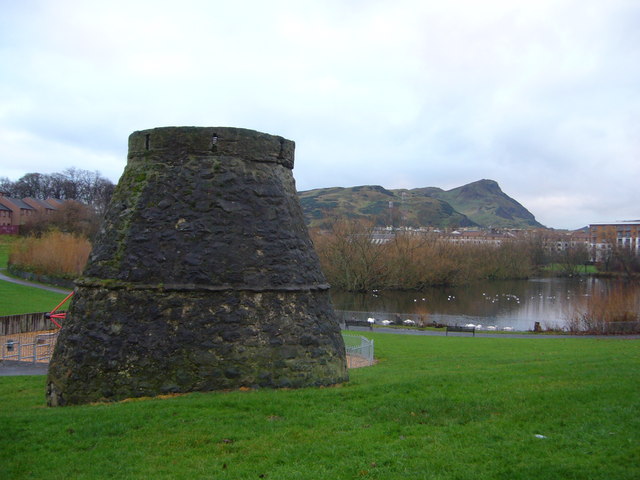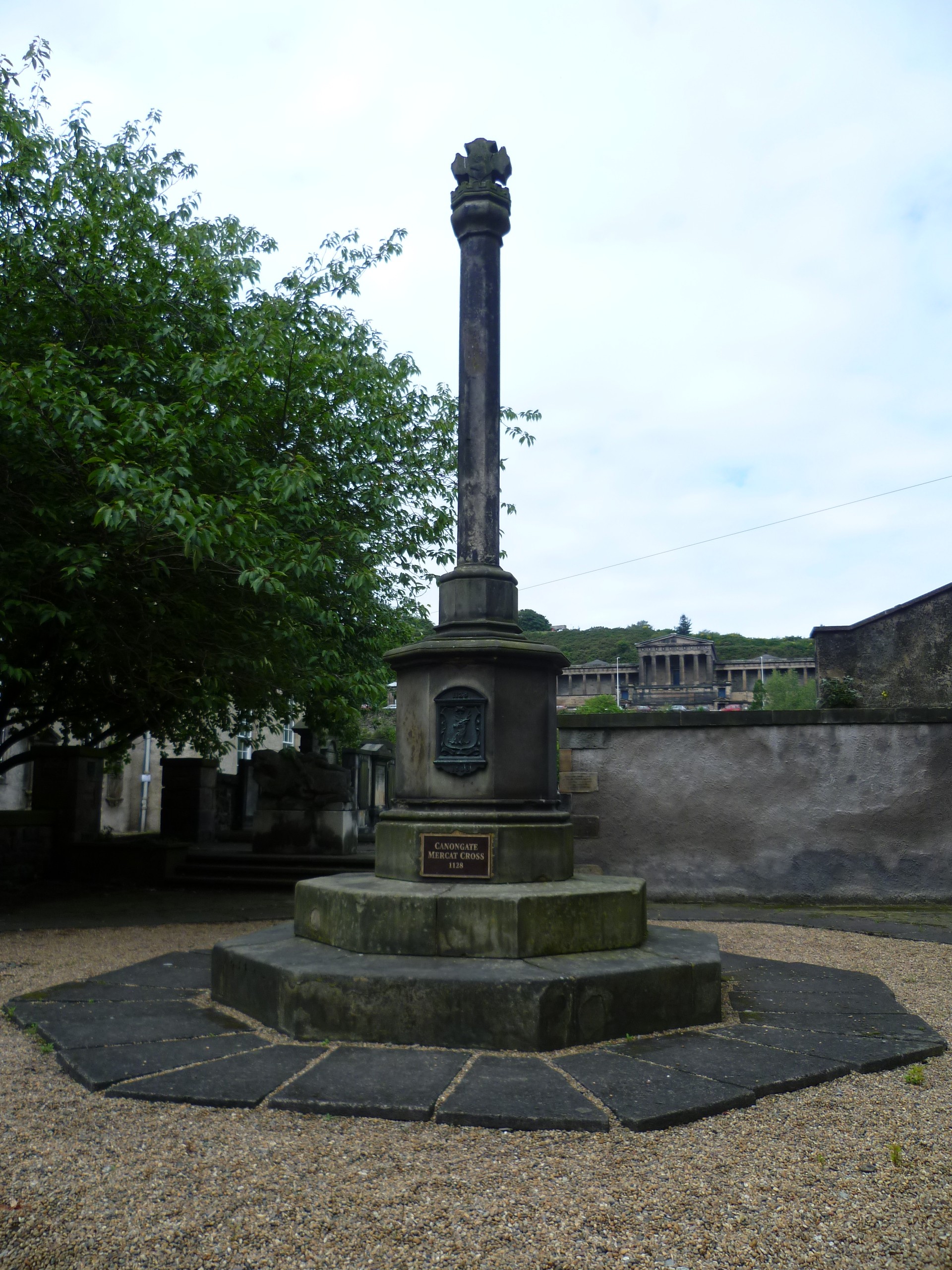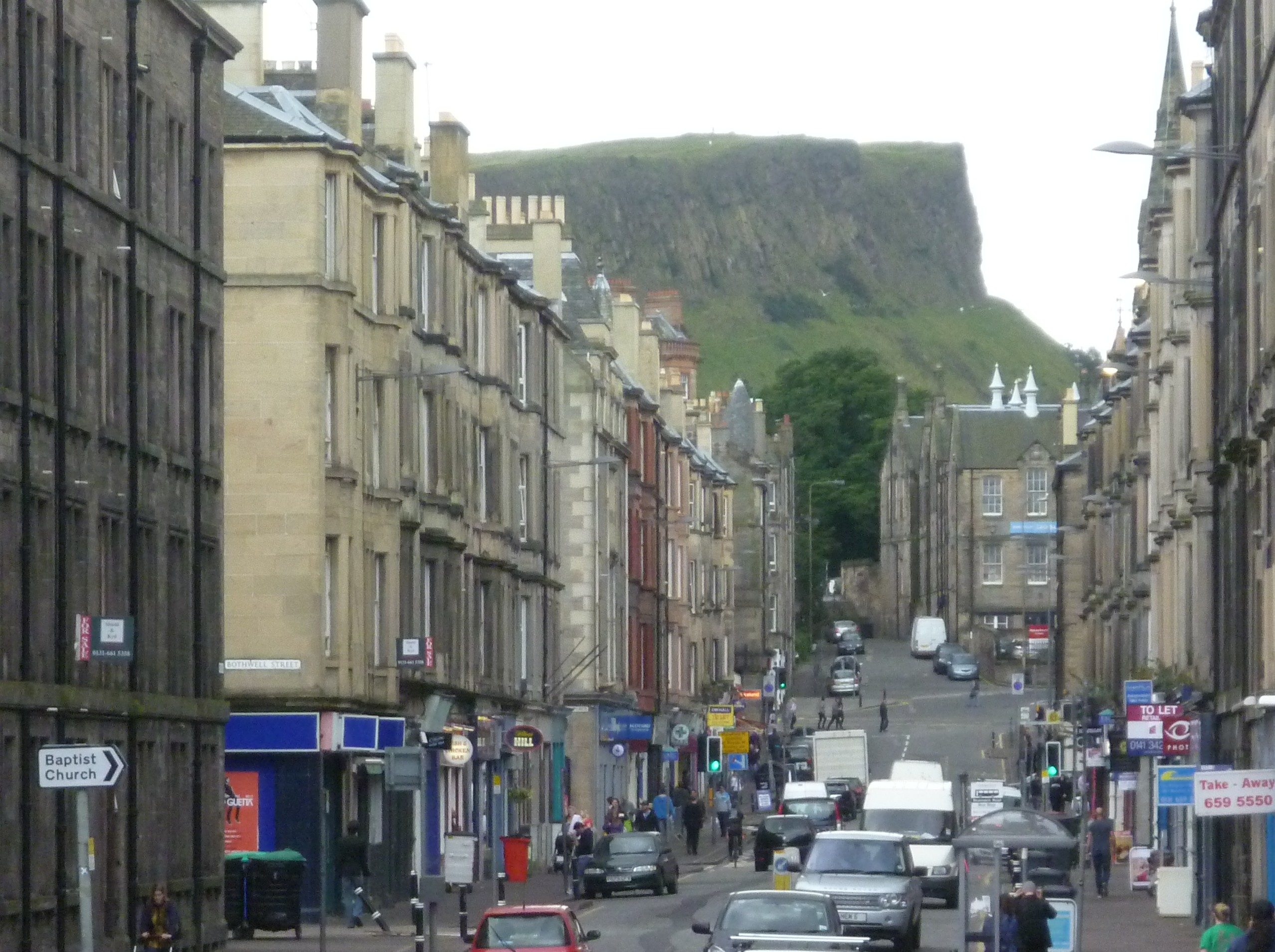|
Lochend, Edinburgh
Lochend is a mainly residential suburb of Edinburgh, the capital of Scotland. It is named after Lochend Castle and the adjacent Lochend Loch, located in the western part of Restalrig on the boundary between Leith and The Canongate, approximately two miles from Edinburgh city centre. The suburb consists largely of a 1930s public housing estate, and is bounded on the west by Easter Road. Lochend Loch is fed from underground springs. With no outlet stream, it was once used for a piped water supply to Leith but was partially filled in the 1960s to reduce water depth for safety reasons, and is now fenced and partly overgrown, providing a wildlife area. It forms a central feature of Lochend Park. Nearby, Lochend Castle was largely demolished in the 16th century, but surviving elements of it form part of the 19th century Lochend House. A 16th century beehive doocot, associated with the castle, stands in Lochend Park. James IV of Scotland came to the Lochend to hunt wildfowl in Septem ... [...More Info...] [...Related Items...] OR: [Wikipedia] [Google] [Baidu] |
Lochend Park - Geograph
Lochend may refer to the following places: Scotland * Lochend, Edinburgh, a suburb of Edinburgh, named after ** Lochend House, an occupied house containing the remnants of a 16th-century castle ** Lochend Loch (Edinburgh), a small lake near Lochend House in Lochend, Edinburgh ** Lochend Park, a public park in Edinburgh * Lochend, Glasgow, a neighbourhood in the Glasgow suburb of Easterhouse ** Lochend Community High School in Easterhouse, Glasgow * Lochend Castle, Campbeltown, a former castle at Campbeltown, Argyll and Bute * Lochend (Loch Ness), a hamlet on the northern shore of Loch Ness * Lochend Loch (Coylton), a small lake in Ayrshire * Lochend Loch in Drumpellier Country Park, Lanarkshire * Lochend Woods, Dunbar, East Lothian Other countries * Lochend Colliery, a former mine near Newcastle, New South Wales, Australia * Lochend House, Campbelltown, an historic home in Adelaide, South Australia * Lochend Road The Canadian province of Alberta has provincial highway netw ... [...More Info...] [...Related Items...] OR: [Wikipedia] [Google] [Baidu] |
Edinburgh
Edinburgh ( ; gd, Dùn Èideann ) is the capital city of Scotland and one of its 32 Council areas of Scotland, council areas. Historically part of the county of Midlothian (interchangeably Edinburghshire before 1921), it is located in Lothian on the southern shore of the Firth of Forth. Edinburgh is Scotland's List of towns and cities in Scotland by population, second-most populous city, after Glasgow, and the List of cities in the United Kingdom, seventh-most populous city in the United Kingdom. Recognised as the capital of Scotland since at least the 15th century, Edinburgh is the seat of the Scottish Government, the Scottish Parliament and the Courts of Scotland, highest courts in Scotland. The city's Holyrood Palace, Palace of Holyroodhouse is the official residence of the Monarchy of the United Kingdom, British monarchy in Scotland. The city has long been a centre of education, particularly in the fields of medicine, Scots law, Scottish law, literature, philosophy, the sc ... [...More Info...] [...Related Items...] OR: [Wikipedia] [Google] [Baidu] |
Scotland
Scotland (, ) is a country that is part of the United Kingdom. Covering the northern third of the island of Great Britain, mainland Scotland has a border with England to the southeast and is otherwise surrounded by the Atlantic Ocean to the north and west, the North Sea to the northeast and east, and the Irish Sea to the south. It also contains more than 790 islands, principally in the archipelagos of the Hebrides and the Northern Isles. Most of the population, including the capital Edinburgh, is concentrated in the Central Belt—the plain between the Scottish Highlands and the Southern Uplands—in the Scottish Lowlands. Scotland is divided into 32 administrative subdivisions or local authorities, known as council areas. Glasgow City is the largest council area in terms of population, with Highland being the largest in terms of area. Limited self-governing power, covering matters such as education, social services and roads and transportation, is devolved from the Scott ... [...More Info...] [...Related Items...] OR: [Wikipedia] [Google] [Baidu] |
Lochend Castle
Lochend House, also known as Restalrig Castle Coventry, Martin (2001) ''The Castles of Scotland''. Goblinshead. p.300 and Lochend Castle, is an occupied house, incorporating the remains of a 16th-century L-plan tower house, in Edinburgh, Scotland. It is located in the Lochend area, about east of Edinburgh Castle. The house is protected as a category B listed building. History The original castle was built on lands originally belonging to the Lestalric family, but which had passed to the Logan family of Restalrig early in the 14th century. That family retained possession until forfeited for their part in the Gowrie conspiracy against King James VI. The castle was burned by William Gilmour of the Inch at that time. Sir Robert Logan was the last member of the family to own the property. Thereafter the property was in the hands of Arthur Elphinstone, 6th Lord Balmerino, from 1704. He was executed in London for his part in the Jacobite rising of 1745, having been captured ... [...More Info...] [...Related Items...] OR: [Wikipedia] [Google] [Baidu] |
Restalrig
Restalrig () is a small residential suburb of Edinburgh, Scotland (historically, an estate and independent parish). It is located east of the city centre, west of Craigentinny and to the east of Lochend, both of which it overlaps. Restalrig Road is the main route through the area, running from London Road, at Jock's Lodge, to Leith Links. It is in the ward of Lochend. History and buildings The place name ''Restalrig'' means ''ridge of the miry land'' (from ''lestal'', a northern dialect term meaning ''mire'' and ''rig'', Scots and northern English meaning a linear field or land-holding). It is first mentioned as Lestalric in 1165, when Edward de Lestalric built a church on the site. The church was completed in 1210 by his grandson, Sir Thomas de Lestalric. The area, over the following centuries, is variously named as Lestalryk, Restalric or Rastalrig. The Norman noble family the de Lestalrics were the ancient landowners in the area (including nearby South Leith). Sir John d ... [...More Info...] [...Related Items...] OR: [Wikipedia] [Google] [Baidu] |
Leith
Leith (; gd, Lìte) is a port area in the north of the city of Edinburgh, Scotland, founded at the mouth of the Water of Leith. In 2021, it was ranked by '' Time Out'' as one of the top five neighbourhoods to live in the world. The earliest surviving historical references are in the royal charter authorising the construction of Holyrood Abbey in 1128 in which it is termed ''Inverlet'' (Inverleith). After centuries of control by Edinburgh, Leith was made a separate burgh in 1833 only to be merged into Edinburgh in 1920. Leith is located on the southern coast of the Firth of Forth and lies within the City of Edinburgh Council area; since 2007 it has formed one of 17 multi-member wards of the city. History As the major port serving Edinburgh, Leith has seen many significant events in Scottish history. First settlement The earliest evidence of settlement in Leith comes from several archaeological digs undertaken in The Shore area in the late 20th century. Amongst the fi ... [...More Info...] [...Related Items...] OR: [Wikipedia] [Google] [Baidu] |
The Canongate
The Canongate is a street and associated district in central Edinburgh, the capital city of Scotland. The street forms the main eastern length of the Royal Mile while the district is the main eastern section of Edinburgh's Old Town. It began when David I of Scotland, by the Great Charter of Holyrood Abbey c.1143, authorised the Abbey to found a burgh separate from Edinburgh between the Abbey and Edinburgh. The burgh of Canongate that developed was controlled by the Abbey until the Scottish Reformation when it came under secular control. In 1636 the adjacent city of Edinburgh bought the feudal superiority of the Canongate but it remained a semi-autonomous burgh under its own administration of bailies chosen by Edinburgh magistrates, until its formal incorporation into the city in 1856. The burgh gained its name from the route that the canons of Holyrood Abbey took to Edinburgh—the canons' way or the canons' gait, from the Scots word ''gait'' meaning "way". In more modern time ... [...More Info...] [...Related Items...] OR: [Wikipedia] [Google] [Baidu] |
Easter Road (street)
Easter Road is an arterial road in north Edinburgh, the capital of Scotland. The road is so called as it was known as the "Easter (eastern) road to Leith". As maps of Edinburgh in the late 18th century show, it had a counterpart in "Wester Road" (now Broughton Road and Bonnington Road). Until the creation of Leith Walk in the middle of the 17th century these were the two main routes from Leith to Edinburgh. Historic personages who have ridden up Easter Road have included Mary, Queen of Scots (1561) and Oliver Cromwell (from Leith Links in 1650). History According to Robert Chambers, writing in 1824, Leith Walk, as its name suggests, was a gravel-surfaced footway, only opened to wheeled traffic after the completion of North Bridge in 1772. Before that Easter Road had been the route taken by coaches running between Edinburgh and Leith. The Edinburgh article in the Statistical Account of Scotland (1791–99) contains evidence from the publisher William Creech that coach tr ... [...More Info...] [...Related Items...] OR: [Wikipedia] [Google] [Baidu] |
Spring (hydrology)
A spring is a point of exit at which groundwater from an aquifer flows out on top of Earth's crust (pedosphere) and becomes surface water. It is a component of the hydrosphere. Springs have long been important for humans as a source of fresh water, especially in arid regions which have relatively little annual rainfall. Springs are driven out onto the surface by various natural forces, such as gravity and hydrostatic pressure. Their yield varies widely from a volumetric flow rate of nearly zero to more than for the biggest springs. Formation Springs are formed when groundwater flows onto the surface. This typically happens when the groundwater table reaches above the surface level. Springs may also be formed as a result of karst topography, aquifers, or volcanic activity. Springs also have been observed on the ocean floor, spewing hot water directly into the ocean. Springs formed as a result of karst topography create karst springs, in which ground water travels through ... [...More Info...] [...Related Items...] OR: [Wikipedia] [Google] [Baidu] |
Dovecote
A dovecote or dovecot , doocot ( Scots) or columbarium is a structure intended to house pigeons or doves. Dovecotes may be free-standing structures in a variety of shapes, or built into the end of a house or barn. They generally contain pigeonholes for the birds to nest. Pigeons and doves were an important food source historically in the Middle East and Europe and were kept for their eggs and dung. History and geography The oldest dovecotes are thought to have been the fortress-like dovecotes of Upper Egypt, and the domed dovecotes of Iran. In these regions, the droppings were used by farmers for fertilizing. Pigeon droppings were also used for leather tanning and making gunpowder. In some cultures, particularly Medieval Europe, the possession of a dovecote was a symbol of status and power and was consequently regulated by law. Only nobles had this special privilege, known as ''droit de colombier''. Many ancient manors in France and the United Kingdom have a dovecote st ... [...More Info...] [...Related Items...] OR: [Wikipedia] [Google] [Baidu] |
James IV Of Scotland
James IV (17 March 1473 – 9 September 1513) was King of Scotland from 11 June 1488 until his death at the Battle of Flodden in 1513. He inherited the throne at the age of fifteen on the death of his father, James III, at the Battle of Sauchieburn, following a rebellion in which the younger James was the figurehead of the rebels. James IV is generally regarded as the most successful of the Stewart monarchs. He was responsible for a major expansion of the Scottish royal navy, which included the founding of two royal dockyards and the acquisition or construction of 38 ships, including the ''Michael'', the largest warship of its time.T. Christopher Smout, ''Scotland and the Sea'' (Edinburgh: Rowman and Littlefield, 1992), , p. 45. James was a patron of the arts and took an active interest in the law, literature and science, even personally experimenting in dentistry and bloodletting. With his patronage the printing press came to Scotland, and the Royal College of Surgeons of Ed ... [...More Info...] [...Related Items...] OR: [Wikipedia] [Google] [Baidu] |
James Balfour Paul
Sir James Balfour Paul (16 November 1846 – 15 September 1931) was the Lord Lyon King of Arms, the officer responsible for heraldry in Scotland, from 1890 until the end of 1926. Life Paul was born in Edinburgh, the second son of the Rev John Paul of St Cuthbert's Church, Edinburgh and Margaret Balfour (granddadughter of James Balfour of Pilrig), at their home, 13 George Square, Edinburgh. His great-grandfather was Sir William Moncreiff, 7th Baronet. He was educated at Royal High School and University of Edinburgh. He was admitted an advocate in 1870. Thereafter, he was Registrar of Friendly Societies (1879–1890), Treasurer of the Faculty of Advocates (1883–1902), and appointed Lord Lyon King of Arms in 1890. He was created a Knight Bachelor in the 1900 New Year Honours list, and received the knighthood on 9 February 1900. Among his works was ''The Scots Peerage'', a nine-volume series published from 1904 to 1914. He tried two interesting heraldic cases in ... [...More Info...] [...Related Items...] OR: [Wikipedia] [Google] [Baidu] |








